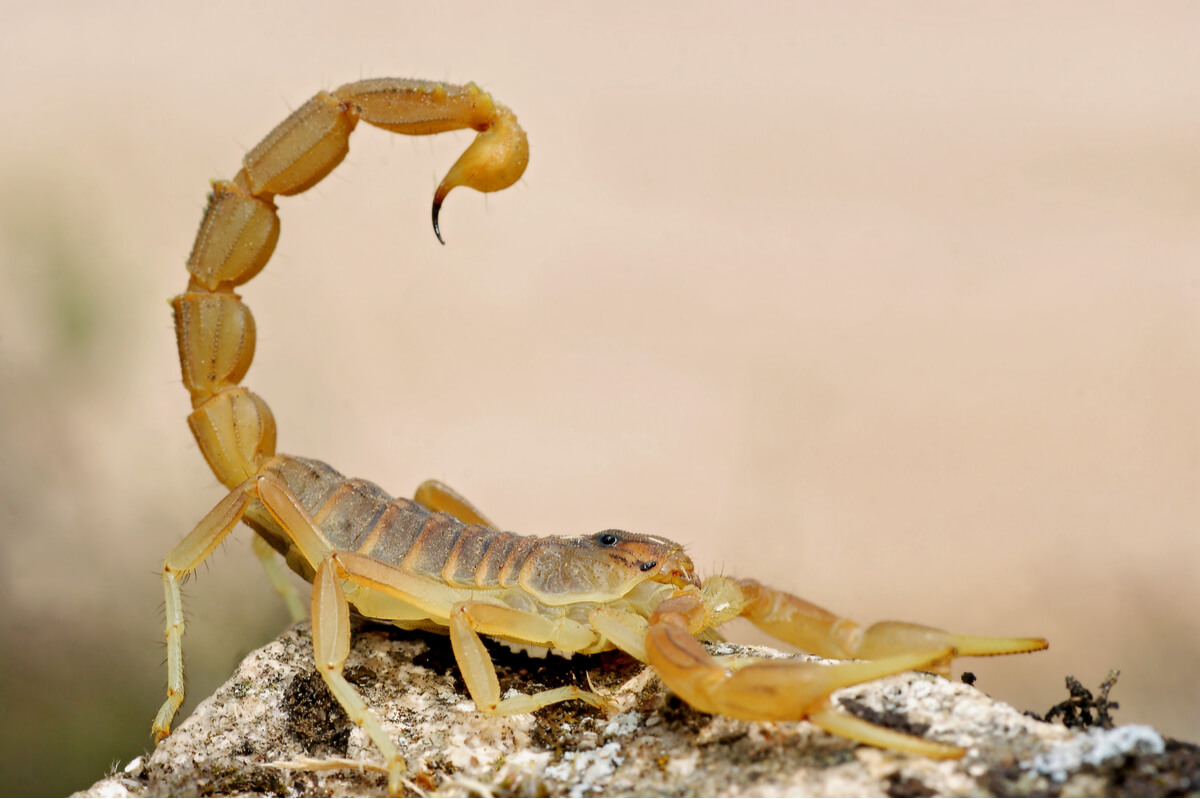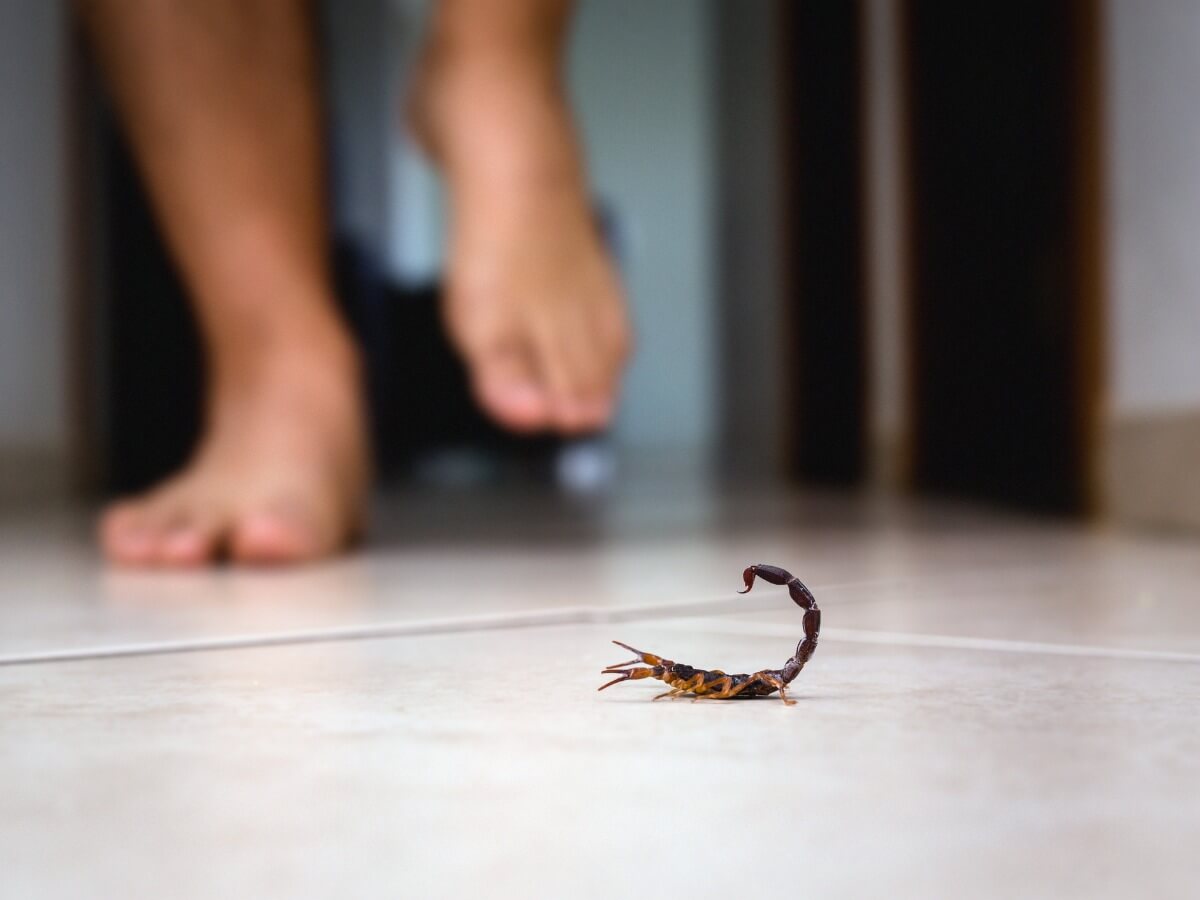Mexico: One of the Countries with the Most Scorpion Stings


Written and verified by the biologist Samuel Sanchez
Scorpions have earned a very negative reputation in our society, because their appearance and their poisonous sting means that we don’t want to get too close to them. These arachnids deserve respect and killing them is never an option, but we can’t deny that their existence is sometimes dangerous for humans. This is exemplified in Mexico, one of the countries with the most scorpion stings in the world.
Although most scorpions stings aren’t fatal, allergic reactions and immunosuppression in some patients can greatly complicate the medical situation. Discover a little more about these arachnids with us today, and where most stings occur.
What are scorpions?
Before going fully into numbers and statistics, we’d like to briefly explore this group. First of all, we need to point out that scorpions are arachnids (Class Arachnida ), and they share a taxon with spiders, ticks, camel spiders and opiliones (daddy longlegs). There are an estimated 2,500 species of scorpions in the world, divided into 22 families.
These invertebrates have a body that divides into 3 segments: the prosoma, mesosoma, and metasoma. The prosoma corresponds to the section of the head and thorax and contains the chelicerae, the pedipalps (clamps or chelas ), the 4 pairs of marching legs, and the sensory organs. The mesosoma is the abdominal region and is made up of 7 segments.
The final part of the scorpion’s body is what draws the most attention, as the metasoma, or tail, is made up of 5 segments and a final telson, which ends in the stinger. This region contains a vesicle that houses a pair of symmetrical poisonous glands in direct contact with the tip of the stinger. With the help of pedipalps, this arachnid is able to quickly inoculate its toxins.
The proper angle for inoculation of the venom is about 30 ° to the tip of the stinger. To achieve this, the scorpion holds its prey with its pincers.

Scorpions and their poison
Despite the bad reputation these animals have, they rarely cause serious problems in humans. As the Mayo Clinic indicates, of the 2,500 species of scorpions that exist, only about 25-30 are lethal to humans. Centruroides sculpturatus, Androctonus crassicauda and Leiurus quinquestriatus are some examples of this.
The most dangerous poisons of these invertebrates are composed of neurotoxins, cardiotoxins, and mycotoxins. This means that they impede the proper functioning of the nervous system, promote heart dysfunctionalities and severely disrupt the mobility of the stung animal. Furthermore, they’re effective at extremely low concentrations.
The average lethal dose (LD50) of the Androctonus crassicauda species is 0.08 milligrams per kilogram of the animal. Intravenously, it only takes about 5.6 milligrams of poison to kill a person.
Mexico: one of the countries with the most scorpion stings in the world
Scorpions are a public health problem that can’t be denied. Their bites are mostly reported in America, Africa, the Middle East, and India and it is estimated that 1.2 million people around the world are stung each year. As indicated by the Medscape portal, this results in more than 3,250 deaths annually. For every person who dies from snake venom, 10 die from scorpions.
As we have said, Mexico is one of the regions that fares worst, with about 200,000 stings a year and more than 300 deaths. This last figure is very conservative, as some sources estimate that about 1000 inhabitants of this country die annually due to this animal’s toxins.
Why this situation?
Undoubtedly, the situation is due to the fact that Mexico’s climate and ecosystem have favored the development of the largest area of scorpion biodiversity in the world. More than 130 species (including subspecies) of these arachnids can be found in this country, as the high temperatures and the dryness of some of its lands greatly favor the survival of scorpions.
Despite this huge biodiversity, it should be noted that only eight species are responsible for almost all the deaths in the country. All of them belong to the genus Centruroides, included in the Buthidae family. Centruroides noxius (in the state of Nayarit), Centruroides suffusus (Durango) and Centruroides limpidus (Morelo) are the most noteworthy.
Mexico is one of the countries with the most lethal scorpion stings due to the abundance of specimens of the genus Centruroides.
Degrees of poisoning
Without a doubt, the scorpions of the aforementioned genus are the most dangerous in the Mexican regions. To bring this article to a close, we’re going to highlight the different reactions to scorpion venom:
- Mild response: Local pain, inflammation, redness of the skin, restlessness, tingling (paraesthesia), hypersalivation, cough, nausea, vomiting, and nasal tingling.
- Moderate response: Drowsiness, body cramps, shortness of breath, paleness, speech problems (dysarthria).
- Severe condition: Seizures, fever, abdominal distension, nystagmus, respiratory failure, heart failure, and death.
To all this, we must add the possibility of the patient developing anaphylactic shock. This means that their immune system responds excessively to the toxins in the venom, developing a series of responses that lead to multi-organ failure and death.
Allergic people, the elderly, children and the sick report a worse prognosis from the bite.

Prevention is the key
Mexico is one of the countries with the most scorpion stings in the world, but this doesn’t mean that it’s impossible to avoid getting stung if you live there. The most important thing is to always check footwear and utensils for human use in places where these invertebrates are very abundant, as they will only sting you if you accidentally crush or grab them.
Other recommendations are to always keep the grass in the garden short, remove any piles of materials that you have indoors or outdoors, place insecticides in the home (to prevent insects from entering, which are scorpions’ prey) and seal doors and windows. If you act with care, it’s possible to avoid getting stung by scorpions.
Scorpions have earned a very negative reputation in our society, because their appearance and their poisonous sting means that we don’t want to get too close to them. These arachnids deserve respect and killing them is never an option, but we can’t deny that their existence is sometimes dangerous for humans. This is exemplified in Mexico, one of the countries with the most scorpion stings in the world.
Although most scorpions stings aren’t fatal, allergic reactions and immunosuppression in some patients can greatly complicate the medical situation. Discover a little more about these arachnids with us today, and where most stings occur.
What are scorpions?
Before going fully into numbers and statistics, we’d like to briefly explore this group. First of all, we need to point out that scorpions are arachnids (Class Arachnida ), and they share a taxon with spiders, ticks, camel spiders and opiliones (daddy longlegs). There are an estimated 2,500 species of scorpions in the world, divided into 22 families.
These invertebrates have a body that divides into 3 segments: the prosoma, mesosoma, and metasoma. The prosoma corresponds to the section of the head and thorax and contains the chelicerae, the pedipalps (clamps or chelas ), the 4 pairs of marching legs, and the sensory organs. The mesosoma is the abdominal region and is made up of 7 segments.
The final part of the scorpion’s body is what draws the most attention, as the metasoma, or tail, is made up of 5 segments and a final telson, which ends in the stinger. This region contains a vesicle that houses a pair of symmetrical poisonous glands in direct contact with the tip of the stinger. With the help of pedipalps, this arachnid is able to quickly inoculate its toxins.
The proper angle for inoculation of the venom is about 30 ° to the tip of the stinger. To achieve this, the scorpion holds its prey with its pincers.

Scorpions and their poison
Despite the bad reputation these animals have, they rarely cause serious problems in humans. As the Mayo Clinic indicates, of the 2,500 species of scorpions that exist, only about 25-30 are lethal to humans. Centruroides sculpturatus, Androctonus crassicauda and Leiurus quinquestriatus are some examples of this.
The most dangerous poisons of these invertebrates are composed of neurotoxins, cardiotoxins, and mycotoxins. This means that they impede the proper functioning of the nervous system, promote heart dysfunctionalities and severely disrupt the mobility of the stung animal. Furthermore, they’re effective at extremely low concentrations.
The average lethal dose (LD50) of the Androctonus crassicauda species is 0.08 milligrams per kilogram of the animal. Intravenously, it only takes about 5.6 milligrams of poison to kill a person.
Mexico: one of the countries with the most scorpion stings in the world
Scorpions are a public health problem that can’t be denied. Their bites are mostly reported in America, Africa, the Middle East, and India and it is estimated that 1.2 million people around the world are stung each year. As indicated by the Medscape portal, this results in more than 3,250 deaths annually. For every person who dies from snake venom, 10 die from scorpions.
As we have said, Mexico is one of the regions that fares worst, with about 200,000 stings a year and more than 300 deaths. This last figure is very conservative, as some sources estimate that about 1000 inhabitants of this country die annually due to this animal’s toxins.
Why this situation?
Undoubtedly, the situation is due to the fact that Mexico’s climate and ecosystem have favored the development of the largest area of scorpion biodiversity in the world. More than 130 species (including subspecies) of these arachnids can be found in this country, as the high temperatures and the dryness of some of its lands greatly favor the survival of scorpions.
Despite this huge biodiversity, it should be noted that only eight species are responsible for almost all the deaths in the country. All of them belong to the genus Centruroides, included in the Buthidae family. Centruroides noxius (in the state of Nayarit), Centruroides suffusus (Durango) and Centruroides limpidus (Morelo) are the most noteworthy.
Mexico is one of the countries with the most lethal scorpion stings due to the abundance of specimens of the genus Centruroides.
Degrees of poisoning
Without a doubt, the scorpions of the aforementioned genus are the most dangerous in the Mexican regions. To bring this article to a close, we’re going to highlight the different reactions to scorpion venom:
- Mild response: Local pain, inflammation, redness of the skin, restlessness, tingling (paraesthesia), hypersalivation, cough, nausea, vomiting, and nasal tingling.
- Moderate response: Drowsiness, body cramps, shortness of breath, paleness, speech problems (dysarthria).
- Severe condition: Seizures, fever, abdominal distension, nystagmus, respiratory failure, heart failure, and death.
To all this, we must add the possibility of the patient developing anaphylactic shock. This means that their immune system responds excessively to the toxins in the venom, developing a series of responses that lead to multi-organ failure and death.
Allergic people, the elderly, children and the sick report a worse prognosis from the bite.

Prevention is the key
Mexico is one of the countries with the most scorpion stings in the world, but this doesn’t mean that it’s impossible to avoid getting stung if you live there. The most important thing is to always check footwear and utensils for human use in places where these invertebrates are very abundant, as they will only sting you if you accidentally crush or grab them.
Other recommendations are to always keep the grass in the garden short, remove any piles of materials that you have indoors or outdoors, place insecticides in the home (to prevent insects from entering, which are scorpions’ prey) and seal doors and windows. If you act with care, it’s possible to avoid getting stung by scorpions.
All cited sources were thoroughly reviewed by our team to ensure their quality, reliability, currency, and validity. The bibliography of this article was considered reliable and of academic or scientific accuracy.
- Scorpion sting, MayoClinic. Recogido a 19 de agosto en https://www.mayoclinic.org/diseases-conditions/scorpion-stings/symptoms-causes/syc-20353859
- Scorpion envenomation, medscape. Recogido a 19 de agosto en https://emedicine.medscape.com/article/168230-overview#:~:text=The%20estimated%20annual%20number%20of,scorpion%20stings%20occur%20per%20year.
- Dehesa-Dávila, M., & Possani, L. D. (1994). Scorpionism and serotherapy in Mexico. Toxicon, 32(9), 1015-1018.
This text is provided for informational purposes only and does not replace consultation with a professional. If in doubt, consult your specialist.








